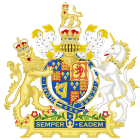Conservators of the River Cam


The Conservators of the River Cam are the navigation authority for the River Cam in Cambridgeshire and were founded in 1702.
History
[edit]Cambridge had been a major inland port as a result of its position on the navigable River Cam for centuries, but this position changed with the draining of the Fens. The most notable change was caused by the construction of Denver sluice on the River Great Ouse, under the terms of the Commonwealth parliament's Drainage Act of 1649, which resulted in tidal waters being cut off from the River Cam. Navigation became difficult, and in 1697, both the University of Cambridge and the town corporation complained to Parliament that the supply of goods to the town from Kings Lynn was greatly impaired.[1]
| River Cam Navigation Act 1702 | |
|---|---|
| Act of Parliament | |
 | |
| Long title | An Act for making the River Cham, alias Grant, in the County of Cambridge, more navigable, from Hyth-Ferry to The Queen's Mill, in the University and Town of Cambridge. |
| Citation | 1 Ann. St. 2. c. 11 |
| Dates | |
| Royal assent | 27 February 1703 |
| Commencement | 20 October 1702 |
| Other legislation | |
| Repealed by | River Cam Navigation Act 1851 |
Status: Repealed | |
Against this background, the corporation sought to obtain an act of Parliament in 1699, which would allow them to reinstate navigation to Cambridge.[1] The act was obtained on 27 February 1702 as the River Cam Navigation Act 1702 (1 Ann. St. 2. c. 11)[2] and established the conservators as a legal body with powers to collect tolls in order to maintain the river. Tolls ranged from four shillings (20p) a ton for wine to one penny (0.4p) for each passenger using the river, and the conservators, of whom there were a maximum of eleven, were empowered to mortgage the tolls in order to raise capital with which to improve the condition of the river. This they did, and built sluices at Jesus Green, Chesterton, Baits Bite and Clayhithe. Most of the tolls were collected at Clayhithe.[1]
Denver sluice collapsed prior to 1820, and although the Corporation of Cambridge opposed its rebuilding, it was rebuilt by 1850. Tolls on the river gradually increased, from £432 in 1752, to over £1,000 in 1803. 1835 was the best year, when tolls reached £1,995, after which they declined again, although they did not drop below £1,000 until 1847. The conservators appear to have managed the river prudently, deriving a little extra revenue in rents from public houses which were constructed at each of the sluices.[1]
| River Cam Navigation Act 1813 | |
|---|---|
| Act of Parliament | |
 | |
| Citation | 53 Geo. 3. c. ccxiv |
| Dates | |
| Royal assent | 21 July 1813 |
| Other legislation | |
| Repealed by | River Cam Navigation Act 1851 |
Status: Repealed | |
| Text of statute as originally enacted | |
The River Cam Navigation Act 1813 (53 Geo. 3. c. ccxiv) gave the conservators powers to raise tolls and to charge penalties, while the Bedford Level Drainage Act 1827 (7 & 8 Geo. 4. c. xlvii) extended their control over the section of river from Popes Corner to Bottisham. This act also increased the number of Conservators by two, as the Mayor of Cambridge and vice-chancellor of the University were appointed as official members of the body. They built locks at Baits Bite and Bottisham, and removed the sluice at Chesterton. They donated £400 towards the cost of rebuilding the Great Bridge in 1823, and a further £300 towards the cost of the small bridge in 1841. The following year they spent £880 on constructing a house at Clayhithe, which included a large room suitable for meetings and banquets.[1]
| River Cam Navigation Act 1851 | |
|---|---|
| Act of Parliament | |
 | |
| Citation | 14 & 15 Vict. c. xcii |
| Other legislation | |
| Amended by |
|
Status: Amended | |
| Text of statute as originally enacted | |
| Canal Tolls and Charges, No. 8 (River Cam, &c.) Order Confirmation Act 1894 | |
|---|---|
| Act of Parliament | |
 | |
| Citation | 57 & 58 Vict. c. cci |
| Dates | |
| Royal assent | 17 August 1894 |
| Text of statute as originally enacted | |
The coming of the railways in 1845 brought to an end the success of the navigation. The commissioners received £1,393 from tolls in 1846 but only £367 in 1850. Two further acts of parliament were obtained, the River Cam Navigation Act 1851 (14 & 15 Vict. c. xcii) and the Canal Tolls and Charges, No. 8 (River Cam, &c.) Order Confirmation Act 1894 (57 & 58 Vict. c. cci), largely to alter the tolls, but receipts continued to fall, to £99 in 1898 and £79 in 1905. By this time, the lower river was managed by the South Level Commissioners, and the River Cam Commissioners again managed the river above Bottisham lock.[1]
Responsibility for the lower river passed to the Environment Agency in 1995, but the conservators remain as the navigation authority for the river above Bottisham lock. The house at Clayhithe still stands, and is now the residence of the foreman of the conservators.[3]
Notable Conservators
[edit]References
[edit]- ^ a b c d e f The Canals of Eastern England, (1977), John Boyes and Ronald Russell, David and Charles, ISBN 978-0-7153-7415-3
- ^ "Joseph Priestley, (1831), Historical Account of the Navigable Rivers, Canals, and Railways, of Great Britain". Archived from the original on 3 March 2016. Retrieved 24 May 2009.
- ^ The River Great Ouse and Tributaries (2006), Andrew Hunter Blair, Imray Laurie Norie and Wilson, ISBN 978-0-85288-943-5
